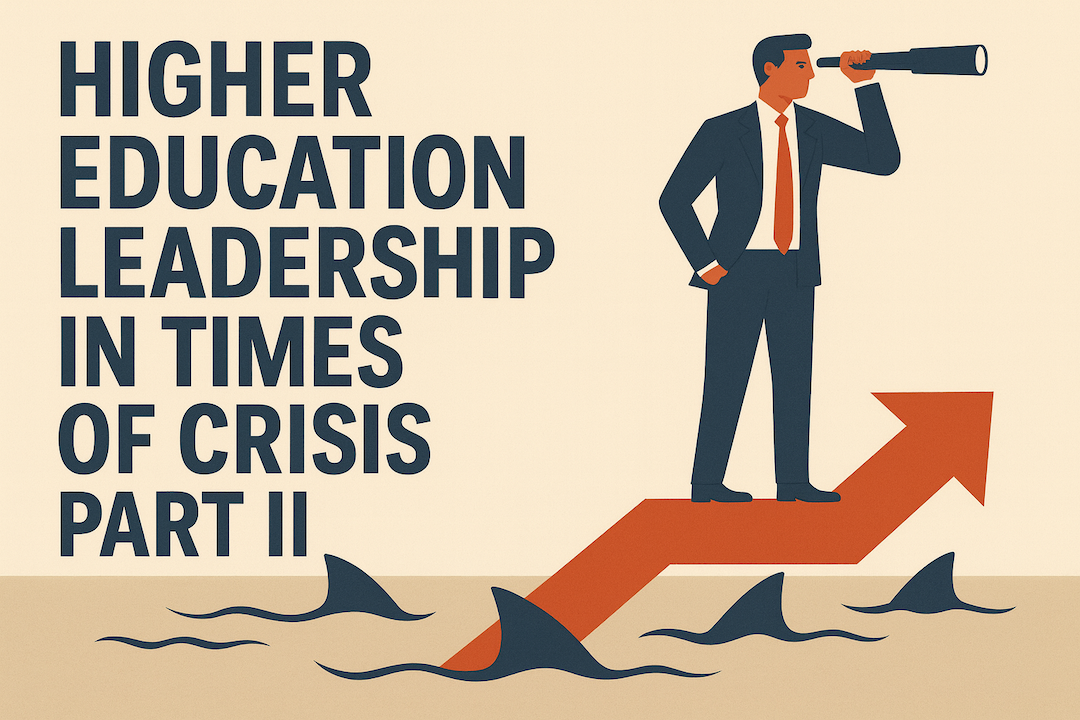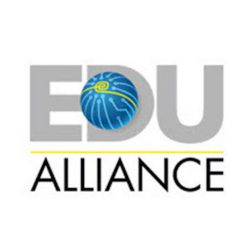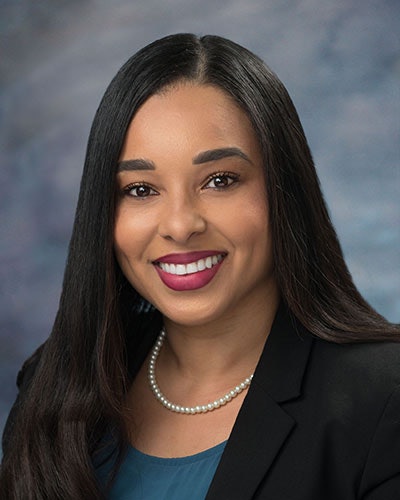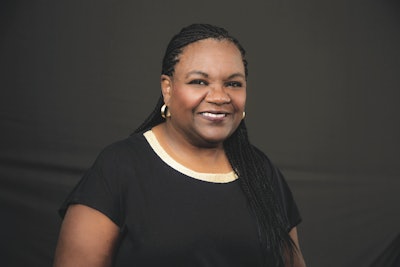By Dr. Barry Ryan, September 15, 2025 – In my August 11th article titled ‘Higher Education Leadership in Times of Crisis,” we established that higher education leadership today cannot be solitary work and that effective crisis response requires both internal and external counsel. Now that you’ve assembled (at least thought through) your cast of trusted advisors and recognized the unique leadership demands of your situation, the next critical step is understanding what you’re actually facing—and how to navigate it successfully. Once you recognize that your organization may be entering such a time, there are three key initial questions to ask:
- How long can a crisis be expected to last?
- What are the effects of crisis on my institution, on my team, on my loved ones, and on me?
- What are some healthy and effective ways I can lead during crisis?
First, how long should I expect a “typical” crisis to last?
At first blush, it might seem a little silly to ask how long a crisis lasts. After all, isn’t that inherently unpredictable?
The answer is “yes” and “no.” It may seem a little flippant to say, but the reality is that the length of a crisis depends to a certain degree on how you and those in leadership alongside you respond to it. Your approach and actions may make it longer or shorter than it would have been. Here’s what I mean.
Ignoring a crisis and hoping that it blows over is actually a potential strategy—although not one that I would recommend in most circumstances. But there are some built-in roadblocks in a university’s life cycle, which is divided largely into annual, semester, or quarter segments. These can act, on their own, as speed bumps or detours that might diminish or change the course of a crisis.
For example, a crisis that is being instigated or aggravated by certain individuals might be relieved to some degree on its own by their departure through retirement, transfer, and so on. Or a financial crisis might be alleviated by the structural limits on certain types of debt that will be paid off, or the inception of certain grants or gifts that are within sight. But these are, unfortunately, uncommon scenarios, and the timing may be unpredictable.
On a global scale, one might think of Winston Churchill trying to imagine how long World War II might last. As futile as such a task might have been, he did, indeed, play out various scenarios and their likely duration. Although it makes for a great quote and probably captures an important aspect of Churchill’s thinking, he likely did not say, “When you’re going through hell, keep going.” But that’s a good reminder for anyone in crisis.
To grossly generalize, I have found that most institutional crises last between six months and two years. Why is that? The more acute ones require quicker action, and the result is either a solution that addresses the issues promptly and efficiently, in, say, six months, and you can move on to other things. Or, failing to find a speedy solution may end with you moving on. (And I don’t mean this lightly, but the reality is that moving on is not the end of the world.)
Why the two-year time frame, on the other end? Because I’ve found that to be about the maximum time frame that a board, or an accreditor, or a creditor, or even a faculty can endure before a solution is reached. Again, the conclusion of the crisis will either leave you in a happier and stronger position in your institution or leave you seeking happiness and a better position somewhere else. But somewhere between six months and two years is what I have found to be the rough lifespan of an intense crisis. (This is barring, of course, a truly existential crisis as a result of which the institution ceases to exist in its current form. But even that drastic of an outcome can easily take two years or more to unfold.)
Second, what are some of the common effects, and how do you survive them?
For the sake of argument, let’s say you become aware that you are entering a crisis period, whether or not it eventually proves to be an existential one. How do you survive in the intervening six months to two years?
Let’s begin with the effects of a continuing crisis on a leader. The crisis can easily become an enormous distraction for someone who already has too much on their plate. The stress that comes with leadership increases in crisis times, with mental, emotional, and even physical effects. Exhaustion can become a daily (and nightly) companion. Self-doubt creeps in and steals even more of the leader’s resources.
It sounds trite, but when this happens, don’t forget to take a few deep breaths – physically and metaphorically.
Draw up a “non-crisis” item list, i.e., things that still need to be done, but aren’t necessarily at the crisis point. Now start divvying them up between and among your fellow leaders, and to their direct reports when possible. This could be an opportune time to help them grow and develop, as well as ease your load.
Along with that, begin to excuse yourself from meetings at which your presence is not absolutely necessary. Only you really know which are and which aren’t. You may still need to attend to some that aren’t technically necessary, but that may prove helpful in crisis-related activities. Again, having trusted substitutes sit in for you for a while can be a growth opportunity for them, and also demonstrate that you trust and empower those with whom you work. When it comes to meetings, which can serve to drain you even more, perhaps adopt a practice of only making limited strategic appearances. Make your participation relevant enough and just long enough to establish your presence and help you – and your colleagues – feel like you’re staying in touch.
Don’t forget to take some days off, or even vacations. Sad but true, don’t make them too long or too far away or somewhere too difficult for you to be reached. You’re probably not really going to relax completely anyway, but you should at least experience some benefit from a change in perspective and place. Frankly, you would do well to consider the health and happiness of your loved ones who’ve been going through this with you, and that they need a break, perhaps even more than you do. After all, you are able to face the crisis more directly, as well as possible enemies, while your loved ones have to suffer vicariously and without the same ability to engage.
Third, how to lead during a crisis?
There is no question that crises have deleterious effects on you, your friends and family, but also your colleagues. You undoubtedly have support and supporters (even though they may seem distant), so don’t neglect them. Their fidelity to the institution and its mission – and you – deserves appreciation and acknowledgement, even if only expressed privately. They’re worried about the institution, but also their livelihood and their colleagues as well.
When they see you, try not to be the deer in the headlights (a situation that doesn’t usually end well in the wild). Appearing indecisive is uninspiring. But so is being overbearing or angry.
Try to be yourself as you were before the crisis. Remember to smile, relax the muscles of your face and neck, and ask them about their loved ones, their teaching, or their research. Be human. The thoughtful ones have an idea about what you’re feeling and going through, so it’s okay for them to see you as a human. You don’t have to adopt a fake effervescence, but you should avoid moping.
Seek impartial counsel. That may, or may not, include colleagues. A small group of confidants is necessary. External friends who have the courage to be honest with you, and also keep complete confidence, can be your best resource to help you gain and keep perspective. They may have higher ed experience, but not necessarily. I have always found that the best counsel comes from folks who have had real challenges, real losses, survived real attacks, and still kept their heads about them. Ones that are “too perfect” are probably not what you need at this point.
While there is a need for you to seek and obtain trustworthy counsel, you should at the same time try to avoid seeking too much counsel. Bottom line is that you’re a leader and you’re going to have to make difficult decisions. So you should accept counsel, but too much can be confusing and even overwhelming.
Look, you’re in a tough position and no matter what you do, some people (possibly including some people you respect and care about) are not going to be thrilled. Sad but true. And some of those feelings may change over time, as they come to a fuller perspective as well.
My advice to leaders in crisis situations always includes two elements:
Can you make a decision that allows you to look at yourself in the mirror?
Then do what you believe is right and let the chips fall where they may. Period.
While you are a leader in a profession you may (or may not any longer) dearly love, there IS an “after.” That may mean continuing in your post-crisis position in the same post-crisis institution, or it may mean more significant changes for you. If so, take what you’ve learned along to whatever comes next. Partings are rarely enjoyable, but I recall a very thoughtful young person we had to let go. His response was remarkable. “I want to learn from this experience and become better as a result.” When I saw him at another institution a year later, he came up to me and said that’s exactly what had transpired and that he was grateful.
Your life, and your legacy, are much more than just this current time of crisis within this current institution. Be grateful to those who have earned that gratitude, and remember who you are.
Dr. Barry Ryan is a seasoned higher education executive, legal scholar, and former president of five universities. He is a senior consultant for the Edu Alliance Group and a legal scholar. With more than 25 years of leadership experience, Dr. Ryan has served in numerous roles, including faculty member, department chair, dean, vice president, provost, and chief of staff at state, non-profit, and for-profit universities and law schools. His extensive accreditation experience includes two terms on the WASC Senior College and University Commission (WSCUC), serving a maximum of six years. He is widely recognized for his expertise in governance, accreditation, crisis management, and institutional renewal.
In addition to his academic career, Dr. Ryan served as the Supreme Court Fellow in the chambers of Chief Justice William H. Rehnquist and is a member of numerous federal and state bars. He has contributed extensively to charitable organizations and is experienced in board leadership and large-scale fundraising. He remains a trusted advisor to universities and boards seeking strategic alignment and transformation.
He earned his Ph.D. from the University of California, Santa Barbara, his J.D. from the University of California, Berkeley, and his Dipl.GB in international business from the University of Oxford.
Edu Alliance Group, Inc. (EAG), founded in 2014, is an education consulting firm located in Bloomington, Indiana, and Abu Dhabi, United Arab Emirates. We assist higher education institutions worldwide on a variety of mission-critical projects. Our consultants are accomplished leaders who use their experience to diagnose and solve challenges.
EAG has provided consulting and executive search services for over 40 higher education institutions in Australia, Egypt, Georgia, India, Kazakhstan, Morocco, Nigeria, Uganda, the United Arab Emirates, and the United States.











